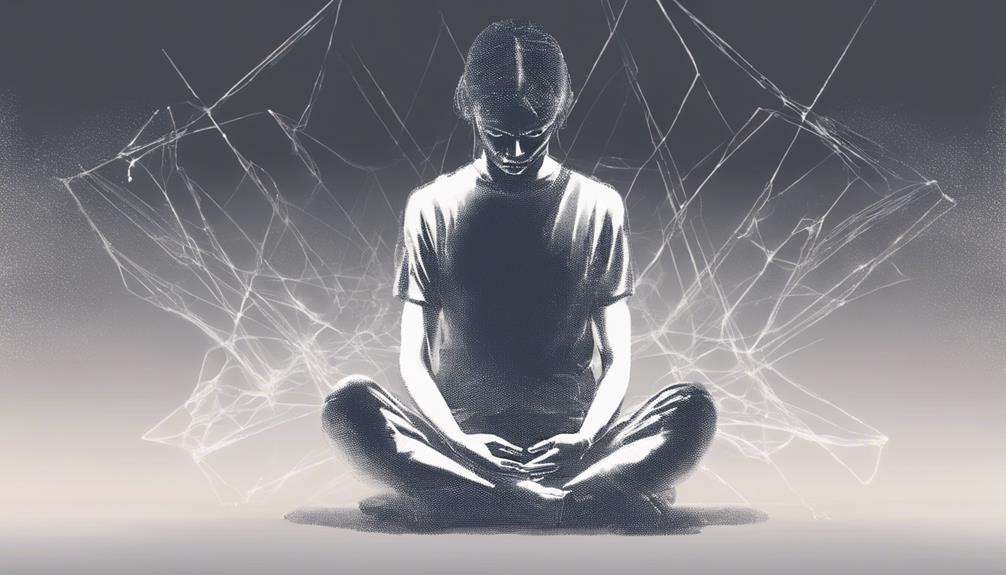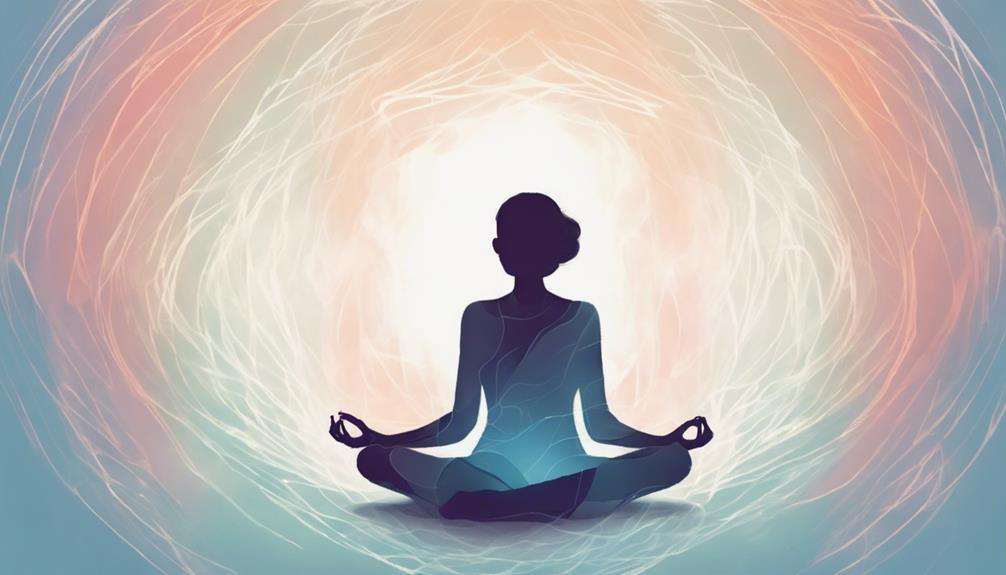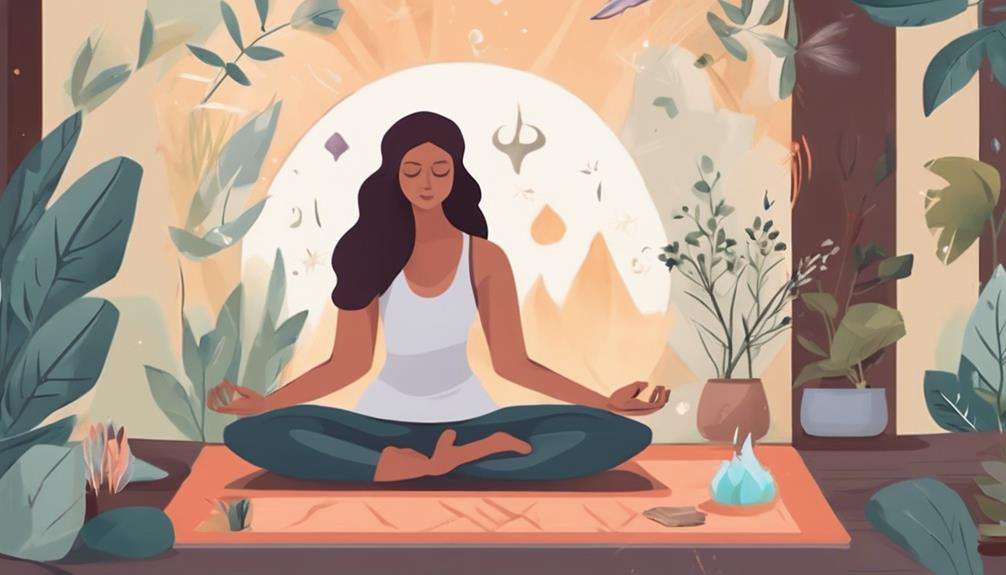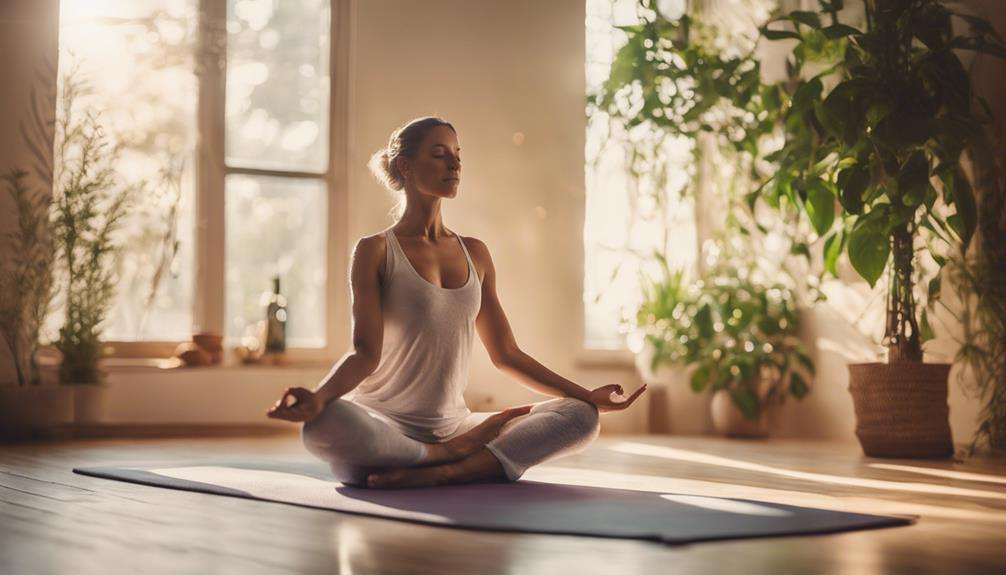Did you know that according to a study by the National Institutes of Health, approximately 31% of adults in the United States will experience an anxiety disorder at some point in their lives?
Understanding how meditation techniques can effectively build resilience against anxiety is crucial for maintaining mental well-being.
By exploring the diverse array of meditation practices tailored to address anxiety symptoms, you can discover a path towards inner peace and emotional stability.
Would you like to unlock the potential of these calming practices to enhance your anxiety resilience?
Key Takeaways
- Mindfulness, loving-kindness, body scan, and guided meditations enhance anxiety resilience.
- These meditation practices cultivate emotional regulation, compassion, relaxation, and tranquility.
- Integration of progressive muscle relaxation offers immediate stress relief and long-term benefits.
- Regular meditation practice rewires the brain, reduces anxiety symptoms, and fosters sustainable resilience.
Mindfulness Meditation for Anxiety Resilience
To build resilience against anxiety, incorporating mindfulness meditation into your daily routine can significantly reduce symptoms and enhance your ability to manage stress effectively. Mindfulness meditation involves focusing on the present moment without judgment, promoting awareness and reducing anxiety.
Research indicates that this practice can decrease symptoms associated with anxiety disorders such as Generalized Anxiety Disorder (GAD) and panic disorder. By engaging in mindfulness meditation, you can regulate your emotions better, improve attention, and decrease stress levels, ultimately enhancing your resilience to anxiety triggers.
Regular practice of mindfulness meditation can lead to rewiring the brain, resulting in increased emotional regulation and reduced reactivity to anxiety-inducing situations. Therapists often use mindfulness meditation as a tool to help individuals manage anxious thoughts and emotions effectively, making it a widely recognized technique in anxiety resilience therapy.
Incorporating mindfulness meditation into your routine can be a powerful ally in your journey towards overcoming anxiety and building emotional resilience.
Loving-Kindness Meditation Techniques
Embrace the practice of Loving-Kindness Meditation, also known as Metta Meditation, to cultivate feelings of love, compassion, and goodwill towards yourself and others. This meditation technique focuses on generating positive emotions by repeating phrases that promote kindness and interconnectedness with all beings.
Research indicates that Loving-Kindness Meditation can reduce symptoms of social anxiety, increase empathy, and foster a sense of connection with others. By regularly practicing this form of meditation, you can enhance self-compassion, promote inner peace, and improve overall emotional well-being.
Directing loving-kindness towards oneself and others can help in developing resilience, reducing self-criticism, and strengthening empathy and compassion. Through Metta Meditation, individuals can create a foundation of positivity and kindness within themselves, leading to a greater sense of harmony and emotional balance.
Start your journey towards increased self-love, compassion, and interconnectedness through the transformative practice of Loving-Kindness Meditation.
Body Scan Meditation for Anxiety Relief

When you practice body scan meditation, you're tuning into your mind-body connection and activating the relaxation response within you.
By systematically scanning through each body part, you can release tension and promote a deep sense of relaxation.
This technique can help you alleviate physical symptoms of anxiety, like muscle tightness, and foster a holistic sense of calmness.
Mind-Body Connection
Engage in body scan meditation to deepen your mind-body connection and alleviate anxiety symptoms effectively. Body scan meditation helps reduce physical symptoms and release tension.
Here's how it can benefit you:
- Promotes relaxation by systematically focusing on different body parts.
- Increases body awareness, aiding in identifying areas of tightness or stress.
- Improves overall well-being by reducing anxiety levels.
- Enhances a sense of calmness and peace, contributing to better anxiety management.
Relaxation Response
Incorporating body scan meditation into your daily routine can effectively trigger the relaxation response, aiding in anxiety relief and promoting a sense of calmness and well-being.
By systematically focusing on different body parts, this practice helps reduce physical symptoms of anxiety, releasing tension and increasing awareness of bodily sensations.
Through this process, the mind is calmed, and overall stress levels decrease, leading to a deep sense of relaxation.
Body scan meditation activates the relaxation response in the body, fostering a profound sense of calm.
Regular practice of body scan meditation can enhance resilience to anxiety triggers and improve emotional well-being, making it a valuable tool in managing anxiety and promoting a sense of peace.
Guided Meditation Practices for Calming
To enhance your relaxation and reduce anxiety, guided meditation practices offer structured support and techniques for calming the mind and body. By engaging in guided meditation, you can experience a sense of tranquility and focus that aids in managing anxious thoughts and promoting overall well-being.
Here are some key elements of guided meditation practices for calming:
- Structured Support: Guided meditation provides a framework for your practice, making it easier to follow along and deepen your relaxation experience.
- Breathing Techniques: Many guided meditations focus on breath awareness, teaching you how to use your breath to calm the mind and body.
- Visualization: Guided imagery can help create a peaceful mental space, allowing you to let go of stress and tension.
- Stay Present: Guided meditations encourage you to stay present in the moment, fostering mindfulness and reducing stress levels effectively.
Engaging in guided meditation can be a valuable tool for those looking to cultivate a sense of peace and calm amidst the pressures of daily life.
Breath Awareness Meditation Benefits

When you focus your attention on the rhythm of your breath, you invite a sense of calmness to permeate through you.
This simple practice strengthens the connection between your mind and body, enhancing your awareness of the present moment.
Calmness Through Breathing
Breath awareness meditation, a practice centered on observing the natural rhythm of your breathing, offers a pathway to cultivating mindfulness and inner calm. When you engage in this practice regularly, you can experience a range of benefits that contribute to your overall well-being:
- Reduce Stress: By focusing on your breath, you can regulate your nervous system and lower stress hormones.
- Promote Relaxation: Breath awareness meditation helps calm your mind and body, promoting a sense of relaxation.
- Enhance Concentration: This practice can improve your concentration and clarity of thought over time.
- Build Resilience: Regular practice can strengthen your resilience to anxiety triggers, enhancing emotional regulation and promoting inner calm.
Through breath awareness meditation, you can nurture your mental well-being and find peace amidst life's challenges.
Mind-Body Connection Strengthened
Strengthen your mind-body connection through breath awareness meditation, fostering a profound sense of presence and relaxation. By honing in on the breath as a focal point, you enhance concentration and diminish distractions, allowing for a deeper state of mindfulness.
This practice empowers you to build resilience against anxiety triggers by attuning to the natural rhythm of your breath. The benefits of breath awareness meditation extend beyond the mental realm, manifesting in physiological changes such as decreased heart rate, lower stress hormone levels, and a calmer nervous system.
With consistent practice, emotional regulation improves, paving the way for a heightened inner peace and overall well-being. Embrace this technique to fortify your mind-body connection and nurture a more balanced, resilient self.
Progressive Muscle Relaxation for Anxiety
With Progressive Muscle Relaxation (PMR), you can effectively reduce anxiety and stress by methodically tensing and relaxing different muscle groups. This technique targets physical tension, promoting relaxation and calmness, making it a valuable tool for managing anxiety disorders. Here's why PMR is beneficial for your well-being:
- Immediate Stress Relief: By systematically tensing and releasing muscle groups, PMR helps release pent-up tension, providing quick relief from stress and anxiety.
- Improved Relaxation: As you practice PMR regularly, you'll notice an overall improvement in your ability to relax, leading to a calmer state of mind.
- Enhanced Well-being: Research supports the positive impact of PMR on anxiety disorders, showing a decrease in symptoms and an overall boost in well-being.
- Easy Integration: PMR is a simple technique that can easily be incorporated into your daily routine, making it a convenient tool for managing stress and anxiety effectively.
Frequently Asked Questions
What Is the 3 3 3 Rule for Anxiety?
When dealing with anxiety, try the 3 3 3 rule. Notice 3 things you see, hear, and feel around you. This simple practice grounds you in the present, easing anxious thoughts and reducing stress.
How to Use Meditation to Overcome Anxiety?
To use meditation for anxiety relief, start with deep breathing exercises and visualization techniques. Practice body scans, mantra meditation, and progressive relaxation. Explore loving-kindness meditation, grounding techniques, guided imagery, movement meditation, and sound therapy for holistic healing.
What Are the Techniques for Managing Anxiety?
To manage anxiety, try breathing exercises, progressive relaxation, visualization techniques, grounding exercises, body scan, guided imagery, mantra meditation, loving kindness, yoga poses, and nature mindfulness. These practices can help ease stress and promote calmness.
How Do You Practice Mindfulness for Anxiety?
To practice mindfulness for anxiety, focus on breath awareness and grounding exercises. Engage in body scans and loving kindness. Try mindful walking, visualization, yoga poses, mantra meditation, progressive relaxation, and sound therapy for a sense of calm and inner peace.
Conclusion
As you navigate the turbulent waters of anxiety, remember that you hold the power to find calm within yourself. By practicing mindfulness, loving-kindness, and body scan meditations, you can create a sanctuary of peace amidst the chaos.
Embrace the rhythm of your breath and let go of tension with progressive muscle relaxation. Seek professional help when needed, but know that you have the tools within you to cultivate resilience and find equilibrium in the storm.






